MORTLOCK
CHINA
This page is for people who are interested in Mortlock China.
If you are interested in collecting Mortlock china then www.ebay.com is a good source of items for sale. Search on 'Mortlock' (make sure you check the little box which causes the descriptions to be searched, not just the titles) at least once a week, since the majority of ebay auctions last 7 days.
Did you know that 'Dickens's Dictionary of London", by Charles Dickens, Jr., 1879, mentions two China and Glass retailers, under the heading "Tradesmen". One is for W. Mortlock & Sons at 18 Regent Street and the other for Mortlock J. & Co. at 204 Oxford Street. Other research indicates that the John Mortlock & Co. may have occupied 202 / 203 / 204 Oxford Street and were most active in the 1800s.
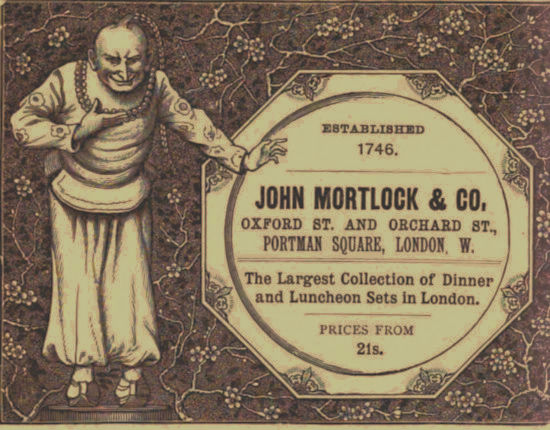
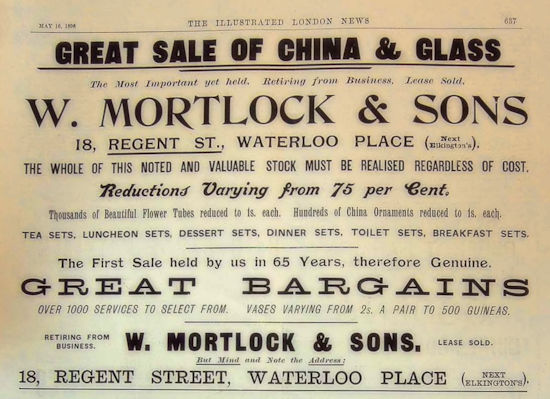
Mortlock items sometimes come up for sale at Trinity Antiques
http://www.rubylane.com/shop/trinityantiques
Below is a picture of one of a plate sold by John Mortlock of Oxford Street. It measures 9" across.
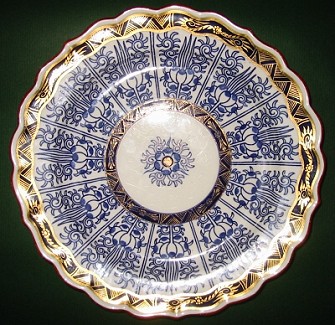

Here is a picture of another John Mortlock plate which I spotted for sale on eBay (thank you very much, to Michael Ewasko for letting me use his pictures).
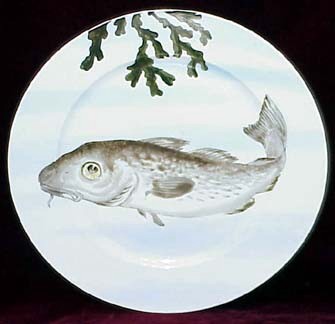
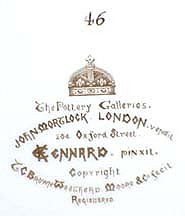
Here is a Mortlock retailed, Belleek scallop shell shaped dish (thanks to Mark Jamison for use of the pictures). The dish is approximately 6" across.
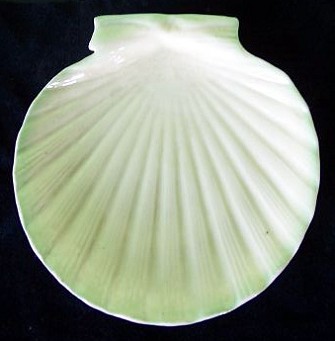
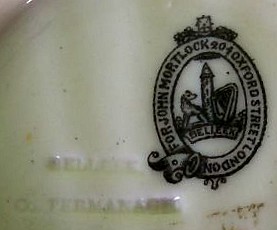
Queen Victoria Ale Jug of 1897 in the style of Doulton. The jug is 6" tall.
(Thanks to Chris Haines of www.royalcoll.fsnet.co.uk for permission to use his pictures).
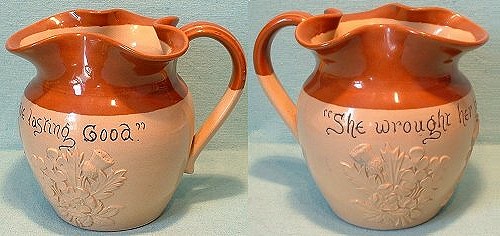

Received Sept 2002
The reason for me contacting you is that I have acquired a Minton china bowl, with the words 'Mortlocks Ltd, 31, 32, Orchard St, London W.' stamped on the base. I had read somewhere about the Minton connection, but went onto the WWW to see what might come up... and hey presto your website. I can confirm three small mentions of the Minton/Mortlock connection in a book by Geoffrey Godden called 'Minton China of the First period 1800-1836'.
Here is an interesting vase sold by John Mortlock of Oxford Street. Thanks to David Brown for the photographs.
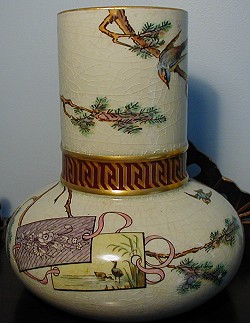
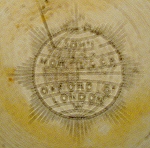
Here is a nice Kitten from John Mortlock of Oxford Street & Orchard Street. The figure measures 5½" high. Thanks to Brian Page Antiques of Brighton, Sussex, England (Tel: +44 (0) 1273 723956) for use of the pictures.
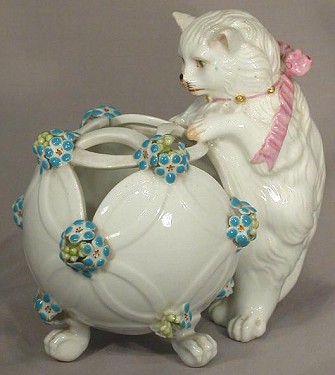

As the image below shows, Mortlock's were also selling china at 8, 9, 10 North Audley Street, which is separated from Orchard Street, by Oxford Street.

This kidney shaped dish is from a set manufactured by Minton, were sold by William Mortlock of Regent street. Thanks to Tony de Lautour for the photographs.
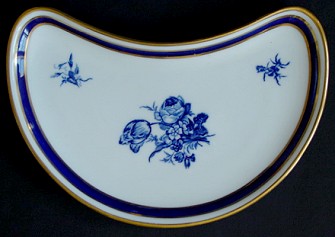
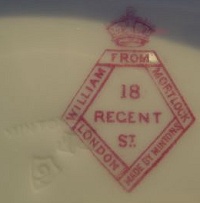
Thanks to eBay seller joesices for these pictures of this Minton plate from William Mortlock of Regent Street.

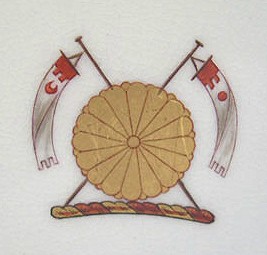

Thanks to James Bateman for the images of this plate depicting the order of the garter, which was supplied to Buckingham Palace by Mortlocks of 18 Regent Street.
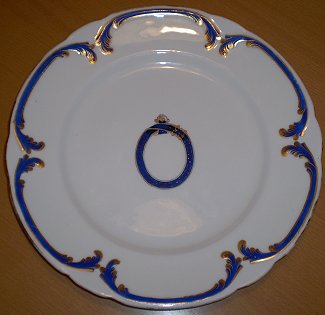
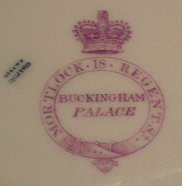
Thanks to Amanda Woodham for the images below. Amanda mentioned that Bisto England was the early name used by Bishop & Stonier.
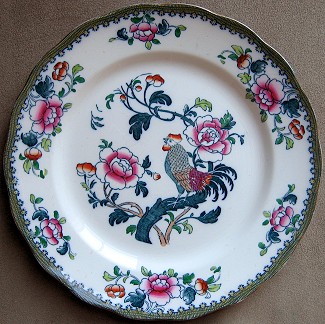
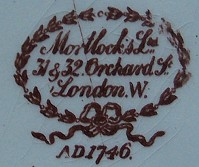
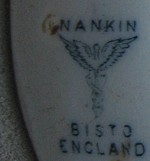
Thanks to Liz Mullaney for this picture of a Minton cup and saucer from John Mortlock in Orchard Street.
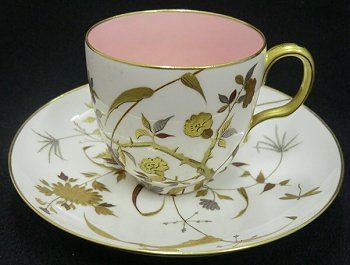
Thanks to http://stores.ebay.com/Treasure-Trove-Worcester?_rdc=1 for this picture of a centre piece from Mortlock's of Oxford & Orchard Street
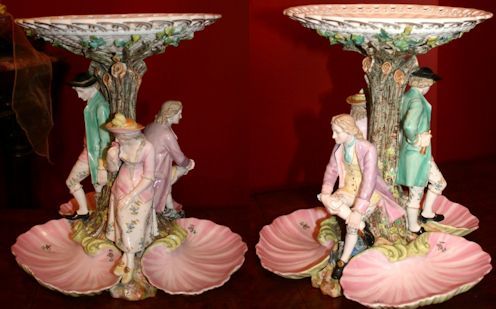
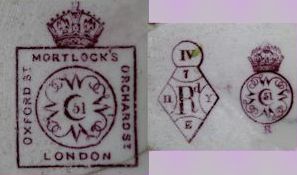
Thanks to eBay seller coversea for permission to use the images of the Victorian glass tumber below. The base of the glass has the logo MORTLOCK - ROYAL - OXFORD ST
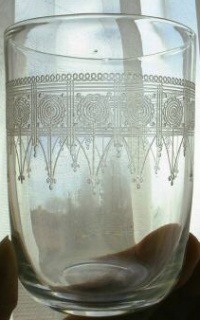
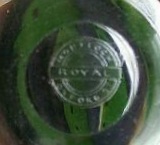
Thanks to Jim Bradshaw for the pictures below and the information in his message:-
" I've been a collector of acid etched glass for a number of years and recently found my first piece with a stamped logo on the base. Whilst looking for details on the web, I came across your web page, which was very helpful in identifying the origin of the glass. As a small thank you, I have attached a couple of photos to add to your archive. The sherry/port glass shown in the photos came as part of an incomplete group, with some identically patterned champagne bowls. Unfortunately, this was the only one with the Mortlock logo, so I assume that one from each set of six would have been marked in this way. Hope this adds a little more information to your archive."
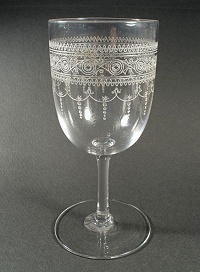
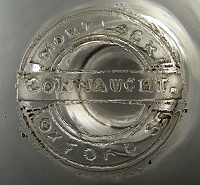
The base of this glass has the logo MORTLOCK - CONNAUGHT - OXFORD ST
Thanks to eBay's orville4 Tel: (01202) 530 for permission to use these pictures of a Mortlock glass decanter.
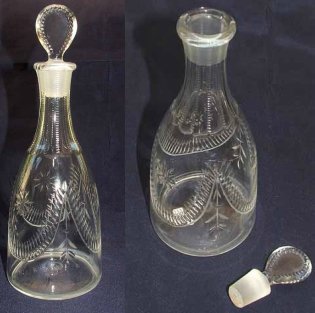
A clock which must have sat in either the John Mortlock Oxford Street or Orchard Street store can be viewed by clicking HERE.
THE ARTICLE BELOW IS EXTRACTED FROM A LARGER DOCUMENT AUTHORED BY Mr. R. J. H. GRIFFITHS, WHICH CAN BE FOUND IN THE MORTLOCK ENCYLOPEDIA
The China Mortlocks
John’s son William made his way to London where, in 1773, he married Elizabeth White. Whether it was he or his son William (1778-1833), who married another Elizabeth (Evans) in London in 1800, who founded the china operation is uncertain. By 1873, and again in 1906, the firm described itself as "founded in 1746"; this cannot have been a Mortlock foundation as the active forebear at that time was John and his will shows him purely as an agriculturalist in Melbourn. Perhaps one of the Williams came into an existing operation via one of the Elizabeths. Certainly the second William is regarded by the appropriate reference books as the founder, which would support a date of 1794 seen on some Mortlock pottery marks. William jnr and both Elizabeths are remembered, together with their children Charles who died aged 8 and Elizabeth who died aged 19, in a tablet on the south wall of Meldreth church.
The company was a merchandising rather than a manufacturing operation. It has been described as arguably the most important china retailer in London in the early nineteenth century. It exercised enormous power and influence over the manufacturers, particularly including Coalport, insisting that the products that Mortlocks sold should bear the Mortlock mark rather than that of the original maker.
Although not a basic manufacturer, Mortlocks, in common with other major London houses, employed independent decorators to finish some of its wares, sometimes on an exclusive basis. These decorators included Robins and Randall of Islington, Thomas Pardoe of Bristol, Thomas Baxter of Clerkenwell who operated as an independent up to 1814, John Powell and John Simms. Besides Coalport made to their order, Mortlocks bought up as much of William Billingsley’s undecorated paste from Nantgarw and Swansea as they could get hold of, finishing it to their customers’ orders, often with a rather overdone result, partly because of the enthusiasm of the decorators and partly because Billingsley’s designs always seemed to borrow from the Brighton Pavilion with mouldings, beadings, animal motifs and acanthus leaves jostling promiscuously for attention. But the customers loved it.
Mortlocks were of course in competition with porcelain produced to order in China and imported by the East India Company and privately by the Hon. Company’s officers. The Mortlock product was of a high quality, with a Coalport dinner service for instance, retailing for 200 guineas - twenty thousand pounds today. A single dinner plate might sell for £8, half a year’s wages for an agricultural labourer. By 1803, almost a century in advance of its formal Royal Warrant, Mortlock was claiming to supply "Her Majesty [Queen Charlotte] and the Royal Family" with "Coalbrook Dale [Coalport] porcelain". In 1825 Mortlock was still advertising his firm as "Colebrook-dale china manufacturers". In the late 1830s Mortlock provided Coalport pieces for Queen Victoria.
In the early years of the twentieth century Mortlocks was first to market with a process to print photographs on porcelain; a complete dinner and tea service, in a mock-Sèvres style, showing photographs of royal residences taken by herself, was commissioned by Queen Alexandra and can be seen (if not by everybody - not publicly on show in 1998) in Windsor Castle. This brought the firm a Royal Warrant of which it was justly proud. Besides Coalport, Mortlocks in 1873 were advertising themselves as retailers for Minton, with rooms at 203/4 Oxford Street and at a newly opened gallery at 31 Orchard Street, Portman Square. They seem to have sashayed up and down Oxford Street; by 1906 they had expanded to three fronts, nos.466-470, whereas, earlier from 1790 (William), through 1811 (John), to 1839 and 1846 (John and Sturges) the firm was relatively static at no.250 (William’s cousin Elizabeth married a corn dealer, John Sturges, in 1812, and William’s son John gave the names Louisa Sturges to his last daughter, who died aged 10 months; she and John and his two wives are buried at Meldreth, together with the heir John George). The Minton connection is probably earlier; Mintons won a major prize at the 1851 Great Exhibition, at which Mortlocks also exhibited and where William Mortlock himself was on the judging panel - which caused no little controversy. The Mortlock stand also featured a Coalport service in the then newly-rediscovered "Rose du Barry", a long-lost Sèvres tint which became popular with super-rich nobility, although the Emperor Napoleon III disappointingly ordered his direct from the manufacturer. Mortlocks traded further afield; they had a stand at the 1873 Exhibition in Vienna. Mortlocks was also noted as a retailer of "Cadogan" teapots which had a sort of patent leaf-avoiding pipe moulded inside.
William’s son John seems to have passed the firm to his eldest son John George of Meldreth Court via a Trust deed during his lifetime, probably in 1880 when he made over to him his farmland at Fowlmere (called by him Foulmire, as above probably the original name before some Victorian bowdlerisation). In 1900 the partners in the china firm are shown as JG, JEF, MJR, GBR, GE, EH and JF Mortlock. GBR is Georgina Blanche Rochford Mortlock, John George’s daughter and executor, who died unmarried in Meldreth in 1931. MJR is her sister Mary Jacqueline Rochford Mortlock and JEF is their brother John Edmund Frederick Mortlock. The unravelling of the names and the sisterly sequence is not helped by the census record for the Meldreth establishment, where the two daughters of John George’s first marriage apparently lived separately from the ménage of his second, in London. This names the second girl as "Jinny" whereas she is actually Frances Rochford Mortlock, who married a Mr Meikleham but then, like her elder sister, predeceased their father. These girls were only 3 and 2 years old when their mother died and probably had six years as the twin apples of their father’s eye before the stepmother, and then further rival half-siblings, and worst of all a male heir appeared on the scene.
John George of Meldreth Court is worth a personal mention. Every weekday morning, in his fine carriage with a coachman in a cocked hat before and a footman behind, he would set off for Meldreth station to catch the 8 a.m. train to London - and if he was late, the train would be kept waiting for him. He had enlarged Meldreth Court, initially built in 1772, by adding a wing of servants’ quarters; running the grounds alone required nine gardeners. On Sunday afternoons the local children were allowed to visit his garden, the fountain playing for their benefit and their visits somewhat encouraged by a scramble for pennies thrown in the air by John George when it was time for them to go home. In summer Meldreth Court hosted village fêtes with races and other diversions. Even more generously, in 1853 he gave land to the parish church on which to build a village school.
The china company finally ceased trading in 1933. The other partners in 1900 appear to be the son (George Ernest) and two (of three) daughters (Jessie Fanny and Ethel Hope) (the oldest, Kate Eleanor or Eleanor Kate, familiarly Nellie, had died in 1893) of John George’s brother Charles Anthony Mortlock. Charles Anthony farmed in Caxton, and is buried there where his grave is marked with a cross which can still be seen. He inherited his father’s property at Melbourn, but there is a whiff of a suggestion that his father had doubts about his financial stability or even his probity - he was cut out of the china business, bequests to him are hedged with clauses protecting against bankruptcy, and the executorship went to his female cousin, perhaps to protect generous bequests to her and her sister. Whether Charles Anthony’s children’s partnerships were vested in them directly by their grandfather or via Charles Anthony is not clear.
Ethel Mortlock the portrait painter, who (perhaps) died in 1928, was born in Cambridge although she lived mostly in London. She appears to be the Charles Anthony’s daughter Ethel Hope, born in Caxton in 1876. She was a pupil of Sir William Orchardson who came to London in 1863. By 1904 she had exhibited 29 works at the Royal Academy; her clientèle of sitters included members of the aristocracy and European nobility, including, by her account, the Shah of Persia and the Chinese Ambassador. These last, by failing to pay the £1000 charged for their portraits, landed Ethel in trouble. Strapped for cash she was caught out when the executors of a racehorse owner called Bleakley found IoUs in his effects for hundreds of pounds. Ethel went to court, claiming that these were offset by painting commissions, but the court found against her and she was told to pay up. Now saddled with legal costs, she was caught again when Captain Noel Hoare, her man of business, died and it was found that he had mortgaged to Hoare’s Bank, without her knowledge (she said), three properties in Sloane Street that she had been building. She tried to buy back one of these but lost a £500 deposit when she could not complete, making a bad situation rather worse. Bleakley’s executors now broke her and her examination in bankruptcy in 1901 can be read in the PRO (BT226/14). Her troubles were attributed to extravagance and betting - the Bleakley IoUs were assumed to be in fact gambling debts and the creditors now included all sorts of tradesmen and the Hotel Cecil where Ethel was now living, presumably in some style. She did not help herself by claiming an income of £250 p.a. when individual commissions were on her own account at the £1000 mark as above. Ethel then upped her declared usual income to a still rather modest £800 and claimed to keep no sort of cash book, accounts, or any memoranda. Proceedings closed with Ethel declared bankrupt and a number of people out of pocket. Ethel went back to her easel. She was unmarried and died in 1928. Sadly one can detect other economies with the truth in her bankruptcy papers - forgivably she is described as "thirty" when thirty-five would be nearer the mark, but also there is no mention of her presumably lucrative partnership in the china firm.
There was, however another Mortlock china enterprise. In 1879 the brothers William and Frederick, sons of a William who died in that year, where trading as china dealers at 18 Regent Street. This enterprise was in business at that address in the father’s hands in 1839 (Pigot’s directory). In 1891 William and Frederick described themselves as "glass and chandelier manufacturers" of 19 James Street "removed to 18 Regent Street" which premises was separately listed by the Post Office as "William Mortlock and Sons". It is possible that the variety of marks, and contradiction regarding the date of foundation, relates to the current reference books not recognising that there were two separate Mortlock china businesses.
The relationships between the principals of the two companies is close. Frederick and William’s father William, sometime Regent Street "china-man", who left £60,000 when he died in 1879, was a son of the 1778-1833 William "of Oxford St". This is provable via their wills and those of their relations, with a little help from IGI. In the will of John Mortlock "of Melbourn" of 1887-9, confirming that provision has been made for his son John George, he nominated as his executrix his spinster niece Clara Louisa, who is clearly identified in the 1879 will of her father Henry, another son of the Oxford St and Meldreth William, as is her sister Fanny, also one of John’s beneficiaries. Henry was a solicitor at Caxton in Cambridgeshire, very near Meldreth and Melbourn which are villages so mutually contiguous as to be almost one settlement. Henry died in 1879. He had played his part in the village as Clerk to the Board of Guardians. Clara Louisa had similarly pulled her weight helping with the management of the village school. Henry’s widow Stephana Ann ran a girls’ school in Caxton, employing Fanny as a teacher. This was a small scale operation and at one point two of the half-dozen or so boarding pupils were Charles Anthony’s eldest daughters. Stephana had reverted to her maiden name of Docwra - which may indicate that she and Henry had separated before his demise. Docwra is an old (and still existing) Cambridgeshire surname which by 1550 had given its name to one of the manors in Shepreth, where in 1548 John is recorded as an adult son of Thomas Docwra. Docwras also have their memorial in a street name in Melbourn.
The fruits of this enterprise and of earlier inheritance were still visible in 1873. The Owned Land survey showed John Mortlock of Melbourn owning 367 acres worth £474 p.a. A John E Mortlock owned 156 acres in "Cambridge" worth £144. This could be the same John and merely refer to some acres outside his main holding. Henry the solicitor owned twenty acres in Caxton worth £64. Acreages worth more than 18 shillings a year, particularly modest ones, can be assumed to bear some useful buildings. As to the Regent Street brothers, Frederick left £43,555 when he died in Norwood in 1915; William became a farmer in Beckenham, Kent, and died there in 1888, at a property called "Tregaron", aged only 52, leaving £39,760. His wife Florence was the daughter of Henry the Caxton solicitor (above). William and Frederick’s sister had married a Stanley Parker, and in the next generation a tribe of Parker Mortlocks found their way back to East Anglia, to landholdings in Worlington, Suffolk where they had Manor Farm. These may however be descendants of William the Chapel Clerk, whom we shall meet shortly.
It looks like Minton, and it feels like Minton (or Coalport) - but turn it over - it may have a Mortlock mark.
References and Sources not mentioned in the text:
Cushion, J "English China Collecting for Amateurs" F Muller 1967
Godden, GA "Encyclopaedia of British Porcelain" London 1988
Messenger, M "Coalport 1795-1926" Antique Collectors’ Club 1995
Butler, Sarah "Meldreth Village" reminiscences, 1972 and 1978
Victoria County History for Cambridgeshire
Correspondence and other contributions, Miss J Reynard and Mr P Mortlock Batchelor
Johnson & Greutzner "Dictionary of British Artists 1880-1904" Collectors’ Club 1976
Wood, C "Dictionary of Victorian Painters" Collectors’ Club 2nd edn 1978
RETURN TO MORTLOCK.INFO MAIN PAGE